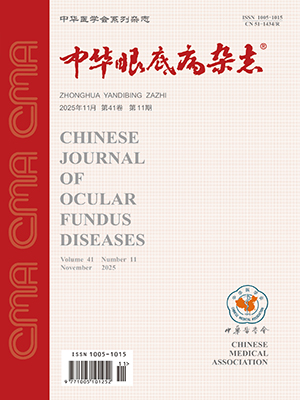| 1. |
Huang H. Pericyte-endothelial interactions in the retinal microvasculature[J/OL]. Int J Mol Sci, 2020, 21(19): 7413[2020-10-08]. https://pubmed.ncbi.nlm.nih.gov/33049983/. DOI: 10.3390/ijms21197413.
|
| 2. |
Ornelas S, Berthiaume AA, Bonney SK, et al. Three-dimensional ultrastructure of the brain pericyte-endothelial interface[J]. J Cereb Blood Flow Metab, 2021, 41(9): 2185-2200. DOI: 10.1177/0271678X211012836.
|
| 3. |
Bek T. Inner retinal ischaemia: current understanding and needs for further investigations[J]. Acta Ophthalmol, 2009, 87(4): 362-367. DOI: 10.1111/j.1755-3768.2008.01429.x.
|
| 4. |
Yu H, Kalogeris T, Korthuis RJ. Reactive species-induced microvascular dysfunction in ischemia/reperfusion[J]. Free Radic Biol Med, 2019, 135: 182-197. DOI: 10.1016/j.freeradbiomed.2019.02.031.
|
| 5. |
Nakahara T, Hoshino M, Hoshino S, et al. Structural and functional changes in retinal vasculature induced by retinal ischemia-reperfusion in rats[J]. Exp Eye Res, 2015, 135: 134-145. DOI: 10.1016/j.exer.2015.02.020.
|
| 6. |
Gonzales AL, Klug NR, Moshkforoush A, et al. Contractile pericytes determine the direction of blood flow at capillary junctions[J]. Proc Natl Acad Sci USA, 2020, 117(43): 27022-27033. DOI: 10.1073/pnas.1922755117.
|
| 7. |
Yemisci M, Gursoy-Ozdemir Y, Vural A, et al. Pericyte contraction induced by oxidative-nitrative stress impairs capillary reflow despite successful opening of an occluded cerebral artery[J]. Nat Med, 2009, 15(9): 1031-1037. DOI: 10.1038/nm.2022.
|
| 8. |
Hall CN, Reynell C, Gesslein B, et al. Capillary pericytes regulate cerebral blood flow in health and disease[J]. Nature, 2014, 508(7494): 55-60. DOI: 10.1038/nature13165.
|
| 9. |
Cheng G, Tian K, Zhang L, et al. S100A4 gene silencing in oxygen-induced ischemic retinopathy inhibits retinal neovascularization via down-regulation of CREB expression[J]. Graefe's Arch Clin Exp Ophthalmol, 2016, 254(1): 97-108. DOI: 10.1007/s00417-015-3158-0.
|
| 10. |
Abu EA, Nawaz MI, De Hertogh G, et al. S100A4 is upregulated in proliferative diabetic retinopathy and correlates with markers of angiogenesis and fibrogenesis[J]. Mol Vis, 2014, 20: 1209-1224.
|
| 11. |
Alarcon-Martinez L, Shiga Y, Villafranca-Baughman D, et al. Pericyte dysfunction and loss of interpericyte tunneling nanotubes promote neurovascular deficits in glaucoma[J/OL]. Proc Natl Acad Sci USA, 2022, 119(7): e2110329119[2022-02-15]. https://pubmed.ncbi.nlm.nih.gov/35135877/. DOI: 10.1073/pnas.2110329119.
|
| 12. |
Yang J, Yang N, Luo J, et al. Overexpression of S100A4 protects retinal ganglion cells against retinal ischemia-reperfusion injury in mice[J/OL]. Exp Eye Res, 2020, 201: 108281[2020-10-06]. https://pubmed.ncbi.nlm.nih.gov/33031790/. DOI: 10.1016/j.exer.2020.108281.
|
| 13. |
Roy S, Tonkiss J, Roy S. Aging increases retinal vascular lesions characteristic of early diabetic retinopathy[J]. Biogerontology, 2010, 11(4): 447-455. DOI: 10.1007/s10522-010-9263-x.
|
| 14. |
Cogan DG, Kuwabara T. Comparison of retinal and cerebral vasculature in trypsin digest preparations[J]. Br J Ophthalmol, 1984, 68(1): 10-12. DOI: 10.1136/bjo.68.1.10.
|
| 15. |
Kugler EC, Greenwood J, MacDonald RB. The "Neuro-Glial-Vascular" Unit: the role of glia in neurovascular unit formation and dysfunction[J/OL]. Front Cell Dev Biol, 2021, 9: 732820[2021-09-27]. https://pubmed.ncbi.nlm.nih.gov/34646826/. DOI: 10.3389/fcell.2021.732820.
|
| 16. |
Trost A, Bruckner D, Rivera FJ, et al. Pericytes in the retina[J]. Adv Exp Med Biol, 2019, 1122: 1-26. DOI: 10.1007/978-3-030-11093-2_1.
|
| 17. |
Dalkara T, Alarcon-Martinez L. Cerebral microvascular pericytes and neurogliovascular signaling in health and disease[J]. Brain Res, 2015, 1623: 3-17. DOI: 10.1016/j.brainres.2015.03.047.
|
| 18. |
Motiejūnaite R, Kazlauskas A. Pericytes and ocular diseases[J]. Exp Eye Res, 2008, 86(2): 171-177. DOI: 10.1016/j.exer.2007.10.013.
|
| 19. |
Kisler K, Nelson AR, Rege SV, et al. Pericyte degeneration leads to neurovascular uncoupling and limits oxygen supply to brain[J]. Nat Neurosci, 2017, 20(3): 406-416. DOI: 10.1038/nn.4489.
|
| 20. |
Huang J, Zhao Q, Li M, et al. The effects of endothelium-specific CYP2J2 overexpression on the attenuation of retinal ganglion cell apoptosis in a glaucoma rat model[J]. FASEB J, 2019, 33(10): 11194-11209. DOI: 10.1096/fj.201900756R.
|
| 21. |
Wang M, Liu H, Xia N, et al. Intraocular pressure-induced endothelial dysfunction of retinal blood vessels is persistent, but does not trigger retinal ganglion cell loss[J]. Antioxidants (Basel), 2022, 11(10): 1864. DOI: 10.3390/antiox11101864.
|
| 22. |
Peppiatt CM, Howarth C, Mobbs P, et al. Bidirectional control of CNS capillary diameter by pericytes[J]. Nature, 2006, 443(7112): 700-704. DOI: 10.1038/nature05193.
|
| 23. |
O'Farrell FM, Mastitskaya S, Hammond-Haley M, et al. Capillary pericytes mediate coronary no-reflow after myocardial ischaemia[J/OL]. Elife, 2017, 6: e29280[2017-11-09]. https://pubmed.ncbi.nlm.nih.gov/29120327/. DOI: 10.7554/eLife.29280.
|
| 24. |
Kiryushko D, Novitskaya V, Soroka V, et al. Molecular mechanisms of Ca(2+) signaling in neurons induced by the S100A4 protein[J]. Mol Cell Biol, 2006, 26(9): 3625-3638. DOI: 10.1128/MCB.26.9.3625-3638.2006.
|
| 25. |
Méhes E, Biri-Kovács B, Isai DG, et al. Matrigel patterning reflects multicellular contractility[J/OL]. PLoS Comput Biol, 2019, 15(10): e1007431[2019-10-25]. https://pubmed.ncbi.nlm.nih.gov/31652274/. DOI: 10.1371/journal.pcbi.1007431.
|
| 26. |
Kilic U, Kilic E, Matter CM, et al. TLR-4 deficiency protects against focal cerebral ischemia and axotomy-induced neurodegeneration[J]. Neurobiol Dis, 2008, 31(1): 33-40. DOI: 10.1016/j.nbd.2008.03.002.
|
| 27. |
Thimmulappa RK, Lee H, Rangasamy T, et al. Nrf2 is a critical regulator of the innate immune response and survival during experimental sepsis[J]. J Clin Invest, 2006, 116(4): 984-995. DOI: 10.1172/JCI25790.
|
| 28. |
Li H, Li J, Zhang G, et al. HMGB1-induced p62 overexpression promotes snail-mediated epithelial-mesenchymal transition in glioblastoma cells via the degradation of GSK-3beta[J]. Theranostics, 2019, 9(7): 1909-1922. DOI: 10.7150/thno.30578.
|
| 29. |
Liu B, Deng X, Jiang Q, et al. Scoparone improves hepatic inflammation and autophagy in mice with nonalcoholic steatohepatitis by regulating the ROS/P38/Nrf2 axis and PI3K/AKT/mTOR pathway in macrophages[J/OL]. Biomed Pharmacother, 2020, 125: 109895[2020-01-28]. https://pubmed.ncbi.nlm.nih.gov/32000066/. DOI: 10.1016/j.biopha.2020.109895.
|




